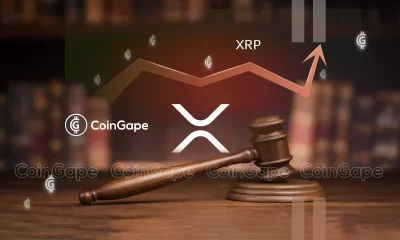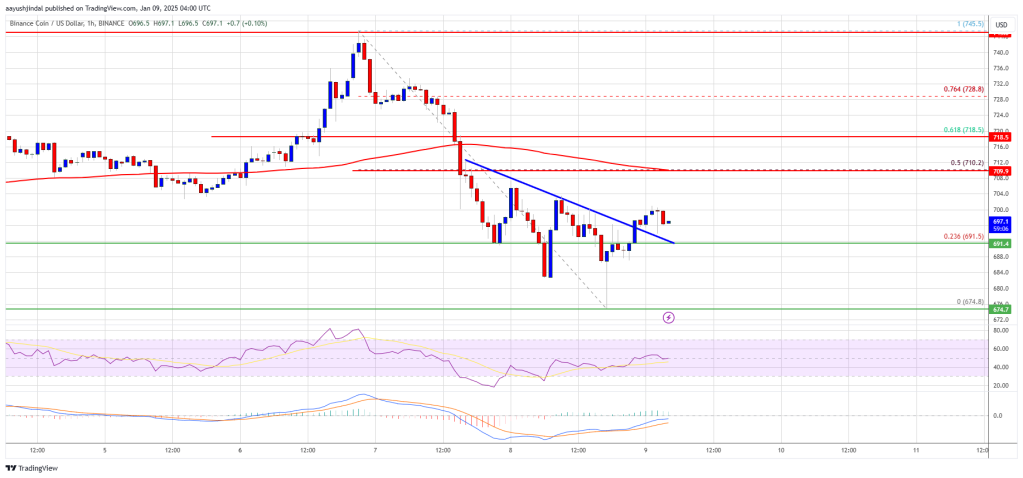Bitwise XRP ETF Filing – Potential 7,000% Gains for ETFSwap
Published
3 months agoon
By
admin
The attention of the crypto market was shifted to the ETFSwap (ETFS) platform that is pioneering the tokenization of ETFs and real-world assets, following the news of Bitwise’s XRP ETF filing. Crypto investors are keeping a close watch on the ETFSwap (ETFS) tokens, which are now being projected to rise by a staggering 7,000%, a feat that is beyond Solana (SOL) and Dogecoin (DOGE).
ETFSwap (ETFS): The Future of Tokenized ETFs
The ETFSwap (ETFS) token stands out for its real-world utility. By tokenizing institutional ETFs and other valuable assets, the ETFSwap (ETFS) platform will provide investors access to high-value asset classes like stocks, commodities, bonds, and crypto ETFs like the newly filed XRP ETF directly from the comfort of their digital devices.
The ETFSwap (ETFS) platform is designed with advanced tools and features aimed at long-term success. Investors are incentivized to stake ETFS tokens and earn up to 87% annual percentage rates (APR), which is a great opportunity for passive income. Additionally, the demand for ETFS tokens is increasing as more users are drawn to its staking rewards and liquidity pools.
The ETFSwap (ETFS) platform allows users to participate in various liquidity pools and provides greater earning opportunities. Traders on the ETFSwap (ETFS) can trade tokenized ETFs with up to 50x margin, and the platform also offersa 10x margin on perpetuals, futures, and commodities to maximize their returns with the potential to achieve gains of up to 20,000%.
The Bitwise XRP ETF filing excites investors in the crypto marketplace. The ETFSwap (ETFS) platform will meet a potential increase in demand for XRP ETFs upon its approval and make them available for investors.
Investors on the ETFSwap (ETFS) platform can easily track ETF prices in real time. ETFSwap (ETFS) has a suite of AI-driven tools, such as the ETF Finder, ETF Filter, and ETF Tracker, which analyze market trends and sentiment to recommend the best ETFs for investors.
Impressively, ETFSwap (ETFS) has successfully completed the KYC verification of its team with SolidProof and a smart contract audit by CyberScope to guarantee security and transparency. The ETFSwap (ETFS) tokens are available in the ongoing presale at the price of $0.03846. With analysts predicting a 7,000% surge that could swiftly take the ETFS tokens to $1 upon their launch, now is the best time for investors to jump on the train and set themselves up for immense profits.
Solana (SOL) And Dogecoin (DOGE) Struggle For Stability
While Solana (SOL) has gained attention for its fast blockchain, the crypto space has also witnessed Solana (SOL) endure frequent outages and reliability issues. Solana (SOL) investors Solana (SOL) appears to have sustainable leadership in token launches due to its infrastructure. The Solana (SOL) network has created over 87% of all new tokens launched among tracked blockchains. But Solana (SOL), currently trading at $144, is yet to retest its previous high of $200 and falls behind the ETFSwap’s (ETFS) momentum for a 7,000% surge.
On the other hand, Dogecoin (DOGE) has relied heavily on its meme status and celebrity endorsements to stay relevant. Due to a lack of intrinsic Dogecoin (DOGE), it is only great for short-term traders seeking to make quick profits from short-lived hype. The inability of Dogecoin (DOGE) to retest its all-time high of $0.72 has been frustrating and resulted in the memecoin being left behind by investors for more valuable assets like the ETFSwap (ETFS) tokens.
The current Dogecoin price is $0.1052 as of the time of writing.
Conclusion: ETFSwap (ETFS) Outpaces Competition In Its Path To $1
The recent Bitwise XRP ETF filing has highlighted the significant importance of ETFs in the crypto space, and the ETFSwap (ETFS) platform stands to benefit greatly due to its exceptional tokenization utility. While Solana (SOL) and Dogecoin (DOGE) may continue to see short-term price action, they can’t compete with the real-world utility, stake rewards, advanced trading options, and the potential to trade XRP ETF that ETFSwap (ETFS) tokens offer.
For more information about the ETFS presale,
Disclaimer
This article is a paid publication and does not have journalistic/ editorial involvement of CoinGape. CoinGape does not endorse/ subscribe to the contents of the article/advertisement and/or views expressed herein. Do your market research before taking any actions . The author or the publication does not hold any responsibility for your personal financial loss.
Source link

You may like


AI suggests 3 top Solana alternatives to boost wallets this first quarter


BNB Price Rebound Possible: Can It Climb Back to $720?


Bitcoin Dips Below $95K, RUNE and INJ Drop 11%


Don't Buy The Bitcoin Dip


ChatGPT’s top 5 crypto picks for the 2025 market surge


XRP Flashing Bullish Signal That Previously Triggered 470% Upside Burst, According to Analyst Ali Martinez
Partner Content
AI suggests 3 top Solana alternatives to boost wallets this first quarter
Published
49 minutes agoon
January 9, 2025By
admin

Disclosure: This content is provided by a third party. crypto.news does not endorse any product mentioned on this page. Users must do their own research before taking any actions related to the company.
AI highlights SUI, TRON, and Rollblock as top Solana alternatives, with Rollblock’s GambleFi solutions leading the charge for Q1 2025 gains.
Staying ahead of the curve is the key to successful crypto trading. Solana did numbers before falling 20% MoM post-US job data. The market fluctuations and FOMO had savvy analysts explore more potential profitable alternatives, and AI has done the heavy lifting. AI identified three top Solana alternatives to elevate user portfolio this quarter: SUI, TRON, and a new GambleFi underdog. Let’s explore what makes this trio the excellent gems for Q1 2025.
Rollblock: A revolutionary platform with explosive potential
Rollblock was the top pick for AI’s suggestions for Solana alternatives. This GambleFi ingenuity has proven to be so much more than the revolutionized iGaming solution. Importantly, it is built using provably fair gaming technology on the blockchain, ensuring everyone can verify that each bet is being overseen fairly and securely.
Its income-generating feature adds to the allure. Users can earn passively by holding Rollblock, a rarity that made it even more attractive to AI. Also, holders can stake their tokens for an 18% APY yield.
Rollblock’s presale proves just how much potential it holds. Selling at just $0.0445 and raising over $8.3 million to date. Its performance is remarkable, and that confirms its superior technical and market relevance.
SUI: Scaling blockchain to new heights
SUI is becoming a high-performance blockchain designed to facilitate efficient and cost-effective dApps and DeFi development. The platform is positioned as a top choice for dApp developers who want reliability. SUI dedicated itself to usability and served different industries, such as gaming, finance, and social networking.
This technical excellence has fueled SUI’s ecosystem growth. According to DeFiLlama, SUI’s TVL rode on the crest of this wave to a $2b ATH. The recent OKX Ventures investment in SUI’s Haedal Protocol has also fueled institutional interest. SUI is a technically rich product with a clear focus on being scalable, and it’s unsurprising it made AI’s picks.
TRON: The veteran blockchain that never slows down
Another alluring Solana alternative that made AI’s suggestions is TRON. TRON started as a decentralized content-sharing platform, expanded to DeFi and NFTs, and has solutions for the enterprise market. Because of its high throughput and low transaction costs, it is an attractive choice for users. TRON’s ecosystem continues to evolve, along with its strategic developments and partnerships.
Recently, Bitget sealed a long-term partnership with TRON that included the acquisition of $10m TRX. This came weeks after Justin Sun hinted at an RLUSD launch on the network. Therefore, TRON is undoubtedly positioned to be one of the most important blockchain players to watch as the crypto market FOMO reaches a new peak.
Conclusion
Binance’s Fear and Greed Index reaching a weekly average of 70 signals growing FOMO, a time to get positioned for the next life-changing opportunity. However, SUI, TRON, and Rollblock present a golden opportunity for this. Although SUI and TRON have been impressive, Rollblock’s momentum has been extraordinary. Rollblock’s iGaming solutions and passive income allure present a compelling narrative for this quarter’s explosive run.
To learn more about Rollblock, visit the website and its socials.
Disclosure: This content is provided by a third party. crypto.news does not endorse any product mentioned on this page. Users must do their own research before taking any actions related to the company.
Source link
Binance Coin
BNB Price Rebound Possible: Can It Climb Back to $720?
Published
1 hour agoon
January 9, 2025By
admin
BNB price is consolidating above the $675 support zone. The price is consolidating and might aim for a fresh increase above the $700 resistance.
- BNB price is struggling to settle above the $700 pivot zone.
- The price is now trading below $700 and the 100-hourly simple moving average.
- There was a break above a connecting bearish trend line with resistance at $695 on the hourly chart of the BNB/USD pair (data source from Binance).
- The pair must stay above the $680 level to start another increase in the near term.
BNB Price Holds Support
After a downside correction, BNB price found support at $675. It is now recovering losses like Ethereum and Bitcoin. There was a move above the $685 level.
The price was able to recover above the 23.6% Fib retracement level of the downward move from the $745 swing high to the $674 low. There was also a break above a connecting bearish trend line with resistance at $695 on the hourly chart of the BNB/USD pair.
The price is now trading below $700 and the 100-hourly simple moving average. If there is a fresh increase, the price could face resistance near the $700 level. The next resistance sits near the $710 level or the 50% Fib retracement level of the downward move from the $745 swing high to the $674 low.
A clear move above the $710 zone could send the price higher. In the stated case, BNB price could test $725. A close above the $725 resistance might set the pace for a larger move toward the $740 resistance. Any more gains might call for a test of the $750 level in the near term.
Another Dip?
If BNB fails to clear the $710 resistance, it could start another decline. Initial support on the downside is near the $685 level. The next major support is near the $675 level.
The main support sits at $650. If there is a downside break below the $650 support, the price could drop toward the $642 support. Any more losses could initiate a larger decline toward the $625 level.
Technical Indicators
Hourly MACD – The MACD for BNB/USD is losing pace in the bearish zone.
Hourly RSI (Relative Strength Index) – The RSI for BNB/USD is currently above the 50 level.
Major Support Levels – $685 and $675.
Major Resistance Levels – $700 and $710.
Source link
24/7 Cryptocurrency News
Bitcoin Dips Below $95K, RUNE and INJ Drop 11%
Published
2 hours agoon
January 9, 2025By
admin
Crypto market today remains in bearish territory as Bitcoin dipped below the $95K mark. Major altcoins followed the downtrend, with several tokens trading in the red. THORChain (RUNE) and Injective (INJ) became the worst performers, both dropping 11% from their daily highs.
The global crypto market today fell by approximately 2%, bringing the total market cap to $3.33 trillion. However, trading volume showed a slight increase of 4% over the last 24 hours, reaching $168 billion. Let’s take a closer look at the top cryptocurrencies by market cap and their current prices.
Crypto Market Today: BTC, ETH, SOL Drop in Bearish Trend
The crypto market today saw a continued bearish trend, with Bitcoin (BTC) down 3%, Ethereum (ETH) falling 2%, and Solana (SOL) dropping 2.5%. Despite the downturn, a positive sign emerged as Bitcoin whales began accumulating BTC once again.
Bitcoin Market Today: BTC Drops 3%, ETF Outflows Continue
Bitcoin price was trading at $94,390, reflecting a 3% drop in the last 24 hours. The 24-hour low and high for BTC stood at $92,559 and $96,666, respectively.
As per SoSo Value data, BTC ETFs witnessed an outflow of $458 million. Fidelity led the sell-off, offloading $258 million worth of Bitcoin. Ark and 21Shares also sold $148 million in Bitcoin, while data from BlackRock’s ETF remains anticipated.
Ethereum Market Today: ETH Price Down 1.5%, ETF Outflows Surge
Ethereum price was down by 1.5%, currently trading at $3,325. The 24-hour low and high for ETH were recorded at $3,210 and $3,387, respectively.
ETH ETFs saw an outflow of $159 million in the past 24 hours, with Fidelity contributing $147 million to the sell-off. The ongoing bearish sentiment continues to impact the crypto market today, reflecting declining prices and significant fund outflows from major institutions.
XRP Market Today: Only Gainer Among Top 10 Coins
XRP price stood out as the only coin in the top 10 to register a gain, rising by 0.40% in the last 24 hours. It was trading at $2.351, with a 24-hour low of $2.214 and a high of $2.396. Additionally, Ripple’s stablecoin RLUSD has been listed on the Bitstamp exchange, adding more utility to the XRP ecosystem.
Solana Market Today: SOL Price Drops 2%
Solana (SOL) price was down by approximately 2%, currently trading at $195.45. Its 24-hour low and high were recorded at $189 and $199, respectively.


Crypto Market Gainers Today
XDC Network
XDC price was up by 7%, now trading at $0.0973. Its 24-hour low and high were $0.087 and $0.0975, respectively. With a market cap of $1.45 billion and a trading volume of $59.35 million, XDC stands out amidst the crypto market today’s overall downturn.
Monero
XMR has been the 2nd top gainer for today, with its price trading at $196, reflecting a 4% increase. Its 24-hour low and high were recorded at $183 and $201, respectively. With a market cap of $3.61 billion and a trading volume of $86.49 million.
Hyperliquid (HYPE), GateToken (GT), and NEO token have also shown gains in the crypto market today, with each token up by 2% to 4% in the last 24 hours. Despite the broader market’s bearish trend, these tokens have managed to perform well.
Crypto Market Losers Today
THORChain
RUNE price was down by 11%, currently trading at $3.94. Its 24-hour low and high were recorded at $3.86 and $4.35, respectively, reflecting a significant decline in the crypto market today.
Injective
INJ price was down by 11% in the last 24 hours, trading at $21.60, with a 24-hour low of $20.54 and a high of $23.88. Despite the downward trend in the market, INJ price has been up by 11% in the last quarter and saw a 13% increase in the past week after the community passed a major governance proposal, amid growing market interest in AI coins.
WIF, MOVE, AIOZ, and SPX have also faced a decline of 7% to 9% in the last 24 hours. This adds to the overall bearish sentiment in the market.
Besides this, the hourly chart also shows a bearish sentiment in the crypto market, with Bitcoin down by 0.13% in the last 24 hours. Fartcoin dropped by 4% in the last hour, and major altcoins are also in the red, reflecting continued selling pressure across the market.
Coingape Staff
CoinGape comprises an experienced team of native content writers and editors working round the clock to cover news globally and present news as a fact rather than an opinion. CoinGape writers and reporters contributed to this article.
Disclaimer: The presented content may include the personal opinion of the author and is subject to market condition. Do your market research before investing in cryptocurrencies. The author or the publication does not hold any responsibility for your personal financial loss.
Source link
AI suggests 3 top Solana alternatives to boost wallets this first quarter
BNB Price Rebound Possible: Can It Climb Back to $720?
Bitcoin Dips Below $95K, RUNE and INJ Drop 11%

Don't Buy The Bitcoin Dip
ChatGPT’s top 5 crypto picks for the 2025 market surge
XRP Flashing Bullish Signal That Previously Triggered 470% Upside Burst, According to Analyst Ali Martinez
FTX Breaks Silence On Backpack’s Alleged Acquisition Of The Defunct Exchange

Steve Hanke Is Wrong About the Strategic Bitcoin Reserve
Shiba Inu may not reach $1, here’s the token to make millionaires in 2025
70 Million DOGE Make Their Way To Binance Amid 10% Dogecoin Price Crash
Terraform Co-Founder Do Kwon’s Trial To Begin In 2026

The Lightning Network Privacy Big Picture: Don't Forget the NSA
Digital banking giant Revolut joins Pyth Network
‘Very Dubious’ Speculation Suggests Bitcoin Could Follow Nasdaq ETF Rallies of 1999: Benjamin Cowen
How Will Donald Trump’s Tariff Plans Impact The Crypto Market?

Ethereum’s lowered yield might signal a paradigmatic shift in the ecosystem

Telegram users can send gifts to friends, TON fails to pump

Bitcoin Could Rally to $80,000 on the Eve of US Elections

Institutional Investors Go All In on Crypto as 57% Plan to Boost Allocations as Bull Run Heats Up, Sygnum Survey Reveals

Crypto’s Big Trump Gamble Is Risky

Arthur Hayes, Murad’s Prediction For Meme Coins, AI & DeFi Coins For 2025

A Kamala Presidency Could Be Just as Bullish for Bitcoin

Ripple-SEC Case Ends, But These 3 Rivals Could Jump 500x

SEC filing underway, Bitcoin rewards app Fold adopts FLD ticker

Cardano and the XRP price action lock in bulls vs bears battle as RCO Finance prepares for 3,000% surge

A16z-backed Espresso announces mainnet launch of core product

Tether CEO Paolo Ardoino Denies Rumors That Stablecoin Issuer Is Under Federal Investigation

Crypto Exchange OKX Moves To Support USDC Ecosystem by Adding Six New Trading Pairs

Trump’s Coin Is About As Revolutionary As OneCoin

Ripple Vs. SEC, Shiba Inu, US Elections Steal Spotlight
Trending

 DeFi3 months ago
DeFi3 months agoEthereum’s lowered yield might signal a paradigmatic shift in the ecosystem

 News3 months ago
News3 months agoTelegram users can send gifts to friends, TON fails to pump

 Bitcoin2 months ago
Bitcoin2 months agoBitcoin Could Rally to $80,000 on the Eve of US Elections

 Bitcoin2 months ago
Bitcoin2 months agoInstitutional Investors Go All In on Crypto as 57% Plan to Boost Allocations as Bull Run Heats Up, Sygnum Survey Reveals

 Opinion2 months ago
Opinion2 months agoCrypto’s Big Trump Gamble Is Risky

 24/7 Cryptocurrency News2 months ago
24/7 Cryptocurrency News2 months agoArthur Hayes, Murad’s Prediction For Meme Coins, AI & DeFi Coins For 2025

 Opinion3 months ago
Opinion3 months agoA Kamala Presidency Could Be Just as Bullish for Bitcoin

 Price analysis2 months ago
Price analysis2 months agoRipple-SEC Case Ends, But These 3 Rivals Could Jump 500x




✓ Share: